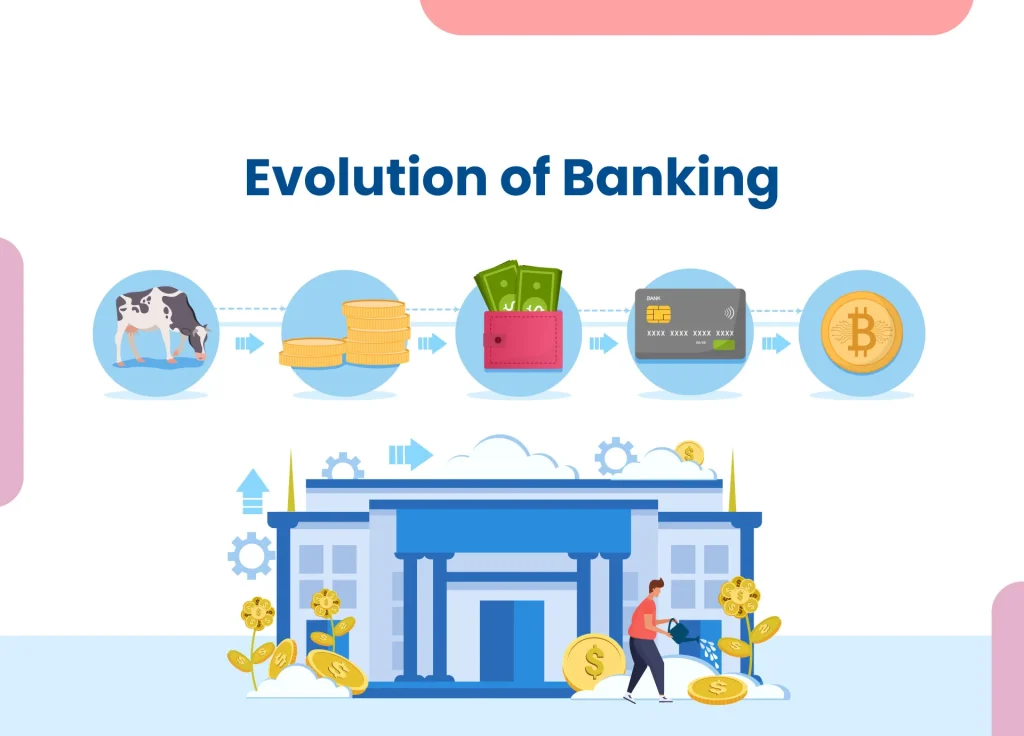
The banking industry has undergone a significant transformation over the past few decades, driven by technological advancements. From traditional brick-and-mortar branches to online banking and mobile apps, the way we manage our finances has changed dramatically. This article explores the technological evolution of banks and credit cards, highlighting the impact of these changes on consumers and the industry as a whole.
The Rise of Online Banking
Online banking emerged in the late 1990s as a convenient alternative to traditional banking. Banks began offering online services, allowing customers to check their account balances, transfer funds, and pay bills from the comfort of their homes. This shift marked the beginning of a new era in banking, where physical visits to branches became less necessary.
Online banking brought several benefits to customers. It offered 24/7 access to banking services, reducing the need to visit a branch during business hours. Additionally, online banking often provided better interest rates on savings accounts and lower fees compared to traditional banking.
For banks, online banking reduced operational costs associated with maintaining physical branches and staff. It also allowed banks to expand their customer base beyond geographical limitations. However, the transition to online banking also posed challenges, such as ensuring the security of online transactions and protecting customer data from cyber threats.
Mobile Banking Revolution
The advent of smartphones brought about the mobile banking revolution. Mobile banking apps provide users with on-the-go access to their accounts, making banking more accessible than ever before. Customers can now deposit checks, pay bills, and transfer money with just a few taps on their smartphones. This convenience has led to a significant increase in the adoption of mobile banking services.
Mobile banking apps have evolved to include a wide range of features. Users can set up alerts for account activity, monitor their spending, and even invest in stocks and mutual funds. The integration of biometric authentication, such as fingerprint and facial recognition, has enhanced the security of mobile banking apps.
The popularity of mobile banking is reflected in the numbers. According to a report by the Federal Reserve, as of 2020, 63% of smartphone owners in the United States used mobile banking apps. This trend is expected to continue as more people become comfortable with managing their finances on their mobile devices.
The Role of Artificial Intelligence
Artificial Intelligence (AI) has played a crucial role in the evolution of banking technology. AI-powered chatbots and virtual assistants provide 24/7 customer service, helping users with their queries and transactions. AI is also used for fraud detection and prevention, analyzing transaction patterns to identify suspicious activities and protect customers’ accounts.
AI has enabled banks to offer personalized services to their customers. By analyzing data on customers’ spending habits and financial goals, AI can recommend products and services tailored to individual needs. For example, AI can suggest investment opportunities or alert customers to potential savings based on their financial behavior.
In addition to customer service and personalization, AI is transforming back-office operations in banks. AI algorithms can automate routine tasks, such as data entry and document verification, reducing the need for manual intervention and minimizing errors. This increases efficiency and allows bank employees to focus on more complex and value-added activities.
Blockchain and Cryptocurrencies
Blockchain technology and cryptocurrencies have introduced new possibilities in the financial sector. Blockchain offers a secure and transparent way to record transactions, reducing the risk of fraud and increasing trust. Cryptocurrencies like Bitcoin and Ethereum provide an alternative to traditional currencies, offering decentralized and secure transactions without the need for intermediaries.
Blockchain technology has the potential to revolutionize various aspects of banking, including cross-border payments, trade finance, and identity verification. By using blockchain, banks can streamline the process of transferring funds across borders, reducing the time and cost associated with traditional methods. In trade finance, blockchain can facilitate the tracking and verification of goods and documents, enhancing transparency and reducing the risk of fraud.
Cryptocurrencies have gained popularity as an investment asset, with many people seeing them as a hedge against inflation and economic uncertainty. However, the adoption of cryptocurrencies for everyday transactions is still limited due to regulatory challenges and volatility in their value. Despite these challenges, some banks and financial institutions are exploring ways to integrate cryptocurrencies into their services.
Contactless Payments and NFC Technology
Contactless payments have gained popularity due to their convenience and security. Near Field Communication (NFC) technology allows customers to make payments by simply tapping their cards or smartphones on a payment terminal. This technology has made transactions faster and more efficient, reducing the need for physical cash.
The adoption of contactless payments has been accelerated by the COVID-19 pandemic, as consumers and businesses seek safer and more hygienic payment methods. According to a survey by Mastercard, contactless transactions grew by 40% globally in the first quarter of 2020.
In addition to NFC, other technologies such as QR codes and digital wallets have contributed to the growth of contactless payments. Digital wallets, such as Apple Pay, Google Wallet, and Samsung Pay, allow users to store their payment information securely on their mobile devices and make payments with a simple tap or scan.
The Emergence of Fintech Companies
Fintech companies have disrupted the traditional banking industry by offering innovative financial services. These companies leverage technology to provide services such as peer-to-peer lending, digital wallets, and robo-advisors. Fintech has made financial services more accessible to a broader audience, including those who are unbanked or underbanked.
Peer-to-peer lending platforms connect borrowers directly with lenders, bypassing traditional banks and offering competitive interest rates. Digital wallets provide a convenient way to store and manage funds, make payments, and transfer money. Robo-advisors use algorithms to offer automated investment advice, making wealth management services accessible to a wider audience.
The rise of fintech has also spurred collaboration between traditional banks and fintech companies. Many banks are partnering with fintech firms to integrate innovative solutions into their offerings and enhance their digital capabilities. This collaboration is driving the development of new products and services that meet the evolving needs of customers.
The Evolution of Credit Cards
Credit cards have also evolved significantly with technological advancements. Modern credit cards come with features such as EMV chips, which enhance security by generating a unique code for each transaction. Contactless credit cards allow for quick and easy payments, while virtual credit cards provide an additional layer of security for online transactions.
EMV (Europay, Mastercard, and Visa) chip technology has become the global standard for credit card security. The chip generates a unique transaction code that cannot be used again, making it difficult for fraudsters to create counterfeit cards. This technology has significantly reduced card-present fraud.
Contactless credit cards use NFC technology to enable quick and secure payments. Users can simply tap their cards on a payment terminal to complete a transaction, without the need to insert or swipe the card. This not only speeds up the payment process but also reduces wear and tear on the card.
Virtual credit cards offer a solution for secure online shopping. These cards generate a temporary card number for each transaction, protecting the user’s actual credit card information. Virtual credit cards are particularly useful for preventing fraud in online transactions and subscription services.
The Impact of Big Data
Big Data has transformed the way banks and credit card companies operate. By analyzing vast amounts of data, banks can gain insights into customer behavior and preferences. This information is used to personalize services, offer targeted promotions, and improve risk management. Big Data also helps in identifying trends and making data-driven decisions.
Customer segmentation is one of the key applications of Big Data in banking. By segmenting customers based on their behavior and preferences, banks can tailor their marketing efforts and offer personalized products and services. For example, a bank might identify customers who frequently travel and offer them travel rewards credit cards with benefits such as airline miles and hotel discounts.
Risk management is another critical area where Big Data is making a difference. Banks can analyze data to assess credit risk, detect fraudulent activities, and predict potential loan defaults. By leveraging predictive analytics, banks can make more informed lending decisions and minimize their exposure to risk.
Big Data is also enhancing customer experience in banking. By analyzing customer interactions and feedback, banks can identify areas for improvement and deliver a more seamless and personalized experience. For example, a bank might use data to identify customers who are likely to be interested in a mortgage and proactively offer them relevant information and assistance.
Cybersecurity in the Banking Sector
With the increase in digital banking services, cybersecurity has become a top priority for banks. Advanced encryption, multi-factor authentication, and biometric verification are some of the measures used to protect customers’ data and prevent cyber attacks. Banks continuously invest in improving their security infrastructure to stay ahead of potential threats.
Encryption is a fundamental security measure that protects data by converting it into a code that can only be deciphered by authorized parties. Banks use encryption to secure online transactions, protect sensitive information, and ensure the privacy of customer data.
Multi-factor authentication (MFA) adds an extra layer of security by requiring users to provide multiple forms of identification before accessing their accounts. This typically includes something the user knows (such as a password), something the user has (such as a smartphone), and something the user is (such as a fingerprint).
Biometric verification, such as fingerprint, facial recognition, and voice recognition, is becoming increasingly common in banking. Biometric authentication offers a high level of security as it relies on unique physical characteristics that are difficult to replicate. This technology is used in mobile banking apps, ATMs, and physical branches to enhance security and prevent unauthorized access.
The Future of Banking Technology
The future of banking technology looks promising, with continuous advancements on the horizon. Innovations such as quantum computing, biometric authentication, and enhanced AI capabilities are expected to further revolutionize the industry. Banks will continue to leverage technology to improve customer experience, streamline operations, and enhance security.
Quantum computing has the potential to transform the banking sector by enabling faster and more efficient data processing. This technology could revolutionize areas such as risk management, fraud detection, and financial modeling, allowing banks to analyze large datasets and make more accurate predictions.
Biometric authentication is set to become even more sophisticated, with advancements in technologies such as iris scanning and vein pattern recognition. These technologies offer a higher level of security and convenience for customers, further reducing the risk of fraud and identity theft.
AI capabilities will continue to evolve, enabling banks to offer more personalized and proactive services. Advanced AI algorithms can analyze customer data in real-time, identifying opportunities for cross-selling and up-selling products and services. AI-powered virtual assistants will become more intelligent, providing customers with instant and accurate responses to their queries.
The technological evolution of banks and credit cards has transformed the financial landscape, offering greater convenience, security, and accessibility to consumers. From online and mobile banking to AI and blockchain, these advancements have made managing finances easier and more efficient. As technology continues to evolve, we can expect further innovations that will shape the future of banking and credit card services.
